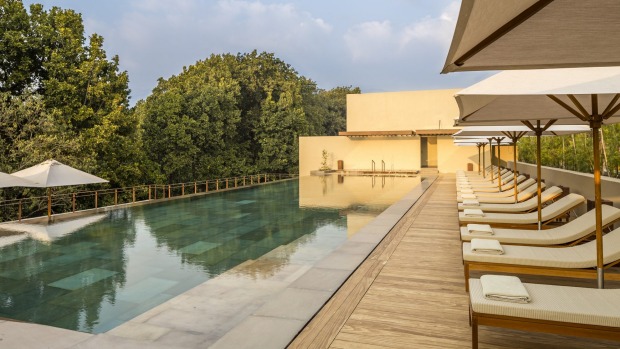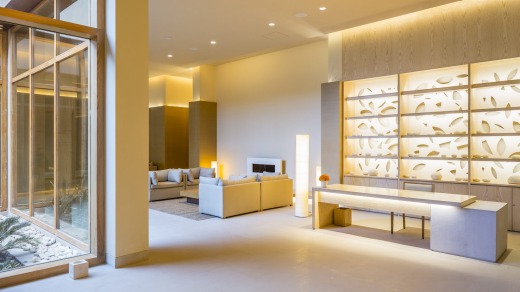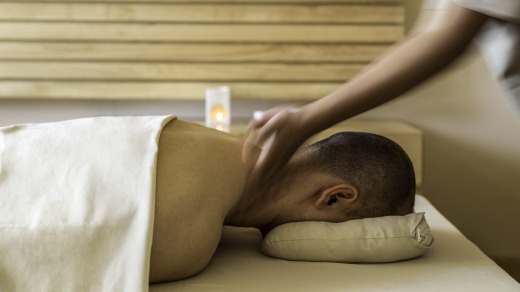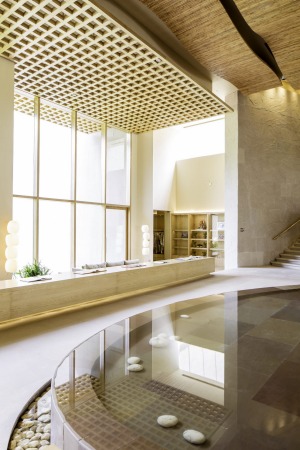
From Dehradun's Jolly Grant Airport, a one-hour flight from Delhi, Thano Road kinks into knots as it threads between forest and farms, and into the foothills of the Himalayas. It's the village India tapestry: cows, goats, sugar cane, mud, scampering langur monkeys and children by the thousand.
This part of Uttarakhand State has long been a place of pilgrimage and a haunt for saddhus, India's wandering holy men. Gangotri, where the Ganges rises, lies to the north-west. Rishikesh and Haridwar, two of Hinduism's holiest cities, are just to the south. Near the bridge over the Song River we pass a Buddhist monastery set on a ridge, and then a monk sitting at a tea shop, bald head shining in the sunlight from a mound of red ochre robes. As the crow flies, Tibet is just over 100km away.
I, too, am on a pilgrimage of sorts. I am expecting that Vana Malsi Estate will be a life changer. A new arrival on India's health and wellness scene, Vana is a five-star ashram, with you as the object of veneration. Yoga, Ayurvedic medicine and meditation find their roots in India, and while there are literally hundreds of retreats that reach out to devotees, the notion of combining them with spa and beauty treatments, spa cuisine and luxury accommodation is foreign to India, at least until Vana opened its doors early in 2014.

At Vana's arrival pavilion, I am greeted as a high-class sadhu should be. My forehead is dabbed with a tilakam, the red holy mark, before a golf cart, perhaps the modern version of Shiva's chariot, transports me to my room.
I'm even dressed for the part. Hanging in my wardrobe is my retreat attire, loose-fitting kurta pyjamas made from bleached cotton, together with a light woollen robe. Wearing them is optional but most do, and it's a practical choice. When I head off for my initial consultation, I feel like a cross between Mahatma Gandhi and Gandalf.
Before arrival, I've been asked to identify my goals, and there's a chocolate-box selection to choose from: natural healing, de-stress, detox, beauty treatments and weight loss. The heavyweight is Panchakarma, minimum 14 nights, a combination of yoga, meditation and Ayurvedic treatments, with the promise of a brand spanking, well-balanced new you at the end of it.

I'm after calm and more flexibility. Nothing too ambitions, but small change is realistic. Giving up wine, or aerial yoga is out of the question. Maybe some relief for chronic lower-back pain. Dr Urvashi considers me coolly as she reads my pulse, a hand on each wrist. I'm Vata with a side-serve of Pitta, two of the three doshas used in Ayurvedic taxonomy. I'm out of balance, she tells me.
On a long list of recommendations, Urvashi prescribes positive visualisation before bed, avoiding exposure to cold air, a glass of warm water when I wake, and warm buttermilk seasoned with rock salt, cumin powder and black pepper at the end of lunch. Also an early morning aloe vera shot with a pinch of turmeric. Only by a miracle will I sustain even a quarter of this when I leave Vana.
Far more feasible is my program, for which the doctor has prescribed a modest two treatments per day. While there are plenty of communal activities – meditation, aqua therapy, om chanting and mindful tea drinking among them – other physical activity is quarantined for one hour before and two hours after each of my treatments, which means oodles of down time, most of it spent lolling by the slate-tiled outdoor pool.

The Ku nye massage takes me into exotic realms. This is a Tibetan Sowa Rigpa treatment, administered by two taciturn Tibetans, trained at an institute of traditional medicine established by the Dalai Lama at Dharamsala. Halfway through the treatment they chant a fast, deep-throated Tibetan Buddhist prayer over my supine self.
My yoga teacher, Dr Dharanj, is strictly old school, a stickler for traditional hatha yoga. It's one-on-one, nowhere to hide. When I mention Bikram yoga, an eyebrow rises behind his black-rimmed glasses, an expression of utter contempt in Dharanj's lexicon of facial gestures. He's the avatar of yoga teachers: professional, calm, adjusting my movements with micrometric precision. He coaxes me into the most adventurous sun salutation ever. "Ankles down, down, stretch. Go through the pain, don't try and hide from it. The pain you are experiencing will help you overcome the pain of life."
My daily Ayurvedic massage involves long, vigorous strokes and lots of slippery oil, until I feel like a sardine. My loincloth – a handkerchief-size strip held in place by a filament of waistband, a cross between a G-string and a nappy – becomes saturated as it absorbs more and more oil. As part of this treatment, my back is pounded vigorously with fist-sized poultices made from herbs wrapped in cotton. The first is pleasantly warm, but as each cools it's replaced by another hotter one. By about poultice No. 5 it's scalding, yet the strange thing is I'm almost asleep, drifting in and out of consciousness, thoughts unravelling into dreams.
The effect of all this oiling, buffing, stretching and massaging is miraculous. In ways that I don't understand I am re-made. Sleeping better, tasting tastes, the nagging inner dialogue quietened, back forgotten, noticing the breeze on my skin and the sounds of birds in the surrounding sal forest.
Vana is the creation of Veer Singh, whose family are major players in India's healthcare industry. Educated in the best schools in India and England, a formative gap year took him to Spain where he developed a passion for organic farming. Singh returned to India a highly motivated eco-warrior, and when his family acquired this hilltop mango and lychee orchard just outside Dehradun with the intention of creating a luxury resort, Veer Singh seized the opportunity to build a sophisticated retreat that fuses Indian traditions and therapies with stylish spa cuisine and a crisp, modern aesthetic – and the Singh family has the kind of resources to make it happen. For Veer Singh and his family it's a toe-in-the-water exercise, the first of what will one day be several Vana Retreats scattered throughout India.
The design is sculptural, with a genuflection in the direction of Frank Lloyd Wright from Vana's smart Spanish architects. The big, blank, earth-coloured rendered walls evoke the adobe architecture of Santa Fe. Salana, Vana's ground-floor restaurant, looks out onto a courtyard arranged with the precise geometry of a Zen garden. White birds hover at cathedral height against the rippling, wave-like ceiling of the Kila, Vana's centrepiece. Huge and softly glowing light spheres are hoisted above Salana's buffet table. The colour scheme is throttled back almost to bland. Taupe is about as bravely into the colour wheel as Vana ventures. Apart from the staff, whose smiled "namaste" is never far from their lips, there is nothing to tell you you're in India. The effect is soothing and calm, but not like most wellness retreats. There's no groaning whale music in the treatment rooms, wine if I feel the urge and espresso whenever I want it, served by a man called Siddharta, who also brews the most exquisite vata tea.
Vana comes with its own requirements. The minimum stay is five nights. Under-16s are banned, as are phones, tablets and laptops in all shared and outdoor spaces. Photography is also not permitted, but the in-room internet is lightning fast, good enough for Skype calls and even streaming video.
What Vana does better than just about anywhere else is offer a chance to remake some part of your life using therapies that are as old as the Bhagavad Gita, with expert tuition to light your way. A life-changing experience, with a silky cocoon as your backdrop.
"Sometimes you just need to be," says Lisa, my Manhattanite mealtime buddy, who has also spent time in California. "A chance to be quiet and allow the doors of perception to open and maybe to pass through. And that's what Vana is, a beautiful, restful place to be"
Amen to that, Lisa. Or, possibly, Om.
For stays at Vana Malsi Estate and travel arrangements throughout India, see www.banyantours.com
Singapore Airlines has flights to Singapore from all Australian state capitals except Hobart, with onward flights to Delhi. Air India and Jet Airways operate between Delhi and Dehradun. See www.singaporeair.com
The minimum stay at Vana Malsi Estate is five nights and the rate per night for two starts at $920, including all meals, daily treatments and transfers. See www.vanaretreats.com